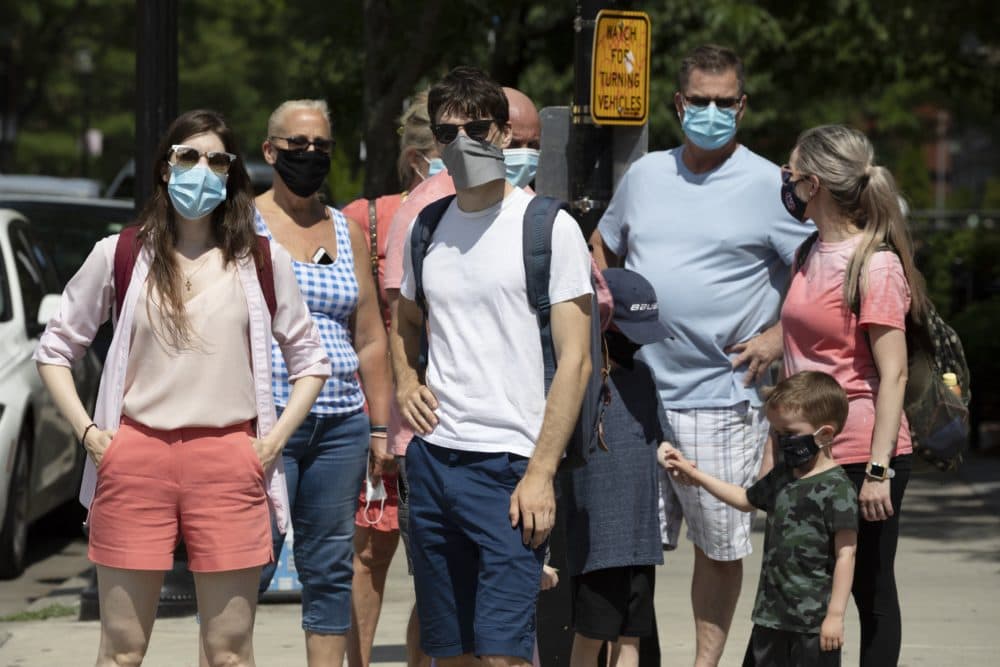Advertisement
Coronavirus Coverage
Pandemic Has 'Fat Tail' With More Superspreading Events Than Expected, MIT Study Finds

New research from MIT calculates that superspreading events are even bigger drivers of the COVID-19 pandemic than previously thought.
The analysis of superspreader events — which the researchers defined as instances where a single person appeared to infect six or more others -- concludes that they aren’t nearly as rare as expected and play a major role in sustaining the pandemic.
"The technical word for it is a fat tail," says lead author Felix Wong, a post-doctoral researcher at MIT. "But really what that gets at is that extreme events that really deviate significantly from the mean are a lot more frequent than what one would predict."
The takeaway, Wong says, is that limiting the size of gatherings is critical; when the researchers simulated a limit of ten contacts per person, he says, the pandemic died down. Here's a bit more of our conversation, lightly edited:
How would you sum up what you found?
We're all familiar with superspreading, including well-documented events like choir practices or weddings. However, we hadn't really known whether these superspreading events were just really anomalies or if they actually contributed to sustaining the disease transmission that we've seen.
We found in our study that superspreading events can indeed be a major driver of the current pandemic. Most people generate zero or one cases, but it's the people generating hundreds of cases that we really should be worried about.
How did you come to that conclusion?
We combined statistical and mathematical analyses, drawing on 60 past superspreading events and comparing them with traditional models in epidemiology. Those models do allow for superspreading to occur, but what we found was that these coronavirus superspreading events occurred more frequently than what these traditional models would have predicted .
The technical word for it is a fat tail, but really what that gets at is that extreme events that really deviate significantly from the mean are a lot more frequent than what one would predict. So it's not like a distribution of, say, human height, where there's a mean and it's really rare to see someone who's like eight feet tall. Here what we're arguing is really the opposite: because of this fat tail, it's really more likely than one would expect that one would see outsized, huge-transmission, superspreading event.
Why might this be?
We didn't really delve into the biology of how superspreading occurs. We personally think that it could be due to many factors, including viral load and social behavior. However, the main point of this study was really just to observe this phenomenon happening.
What are the policy implications?
Policy-wise, I would say that our work suggests imposing a tight limit of around 10 people in a gathering. And actually, when we did a mathematical simulation of this, a simulation in which everyone was limited to at most ten contacts, we found out COVID would have rapidly died down.
We've known since early on that superspreading events in this pandemic were very important. What does this add?
This is really how science works: most of us think something is important, but it remains to be quantified how important. Since February there have been reports of one person transmitting to dozens if not hundreds of people. But these might just be anomalies, just freak events that don't necessarily contribute to the millions of cases.
What we're showing is that these events actually occur, perhaps undetected, just naturally, and that this really is what's sustaining the current pandemic, not something like your uncle transmitting it to one person. We define a superspreading event as someone who infects at least six people.
Can you quantify how common these events are?
I would say the main contribution of this work is not only to assemble this kind of database of superspreading events but also to quantify more precisely how often one would expect them to be. This gets a little technical but broadly speaking, it's really different from a normal distribution, say. The probability of observing one of these events is, I would say, a multiple higher — say, 10 times higher based on our empirical data — than what one would expect based on a normal distribution.
In a normal distribution, you have this kind of exponentially decaying tail, where the probability is decreasing really quickly. What we found in this study was this fat tail phenomenon, meaning the probability decreases not exponentially fast, but less fast.
Is this very surprising to epidemiologists?
My co-author Jim Collins and I aren't epidemiologists, we're more like quantitative biologists. But I would point out that most epidemiology studies seem to really rely on the assumption of a homogeneous population, assuming that everyone's basically equal, that everyone transmits the virus to about three people. What this study contributes is an alternative view, suggesting that there might be more heterogeneity in this disease transmission than we thought.
It would be great to be able to identify these superspreaders. But one thing that we can for sure do is just avoid situations in which we could be the targets of superspreaders or be superspreaders ourselves.
